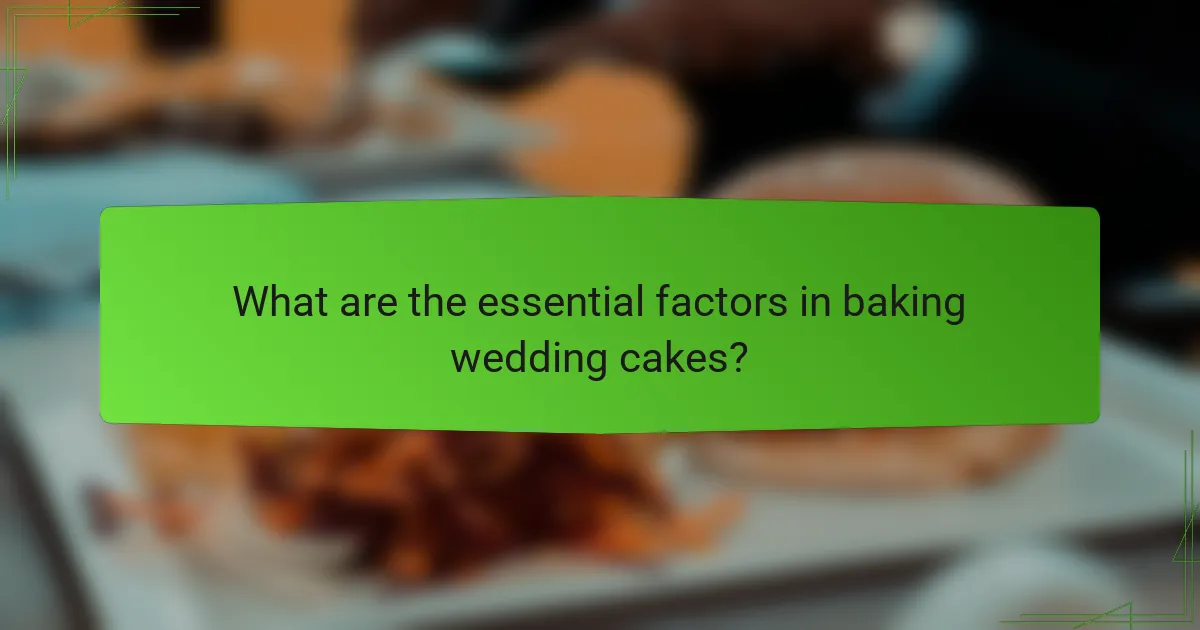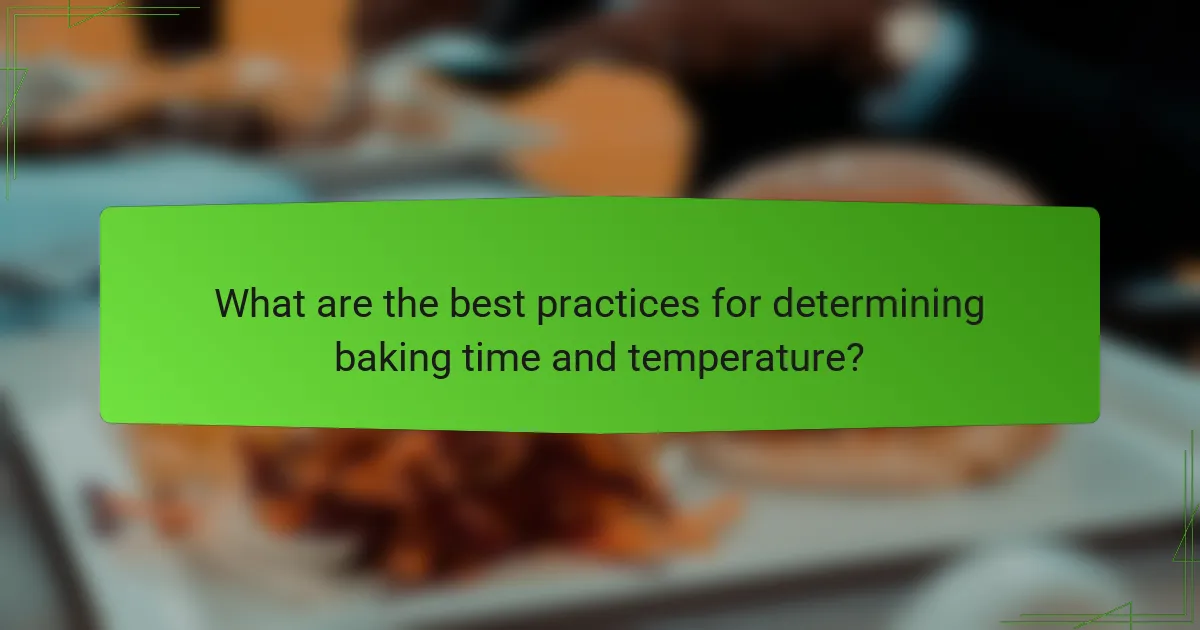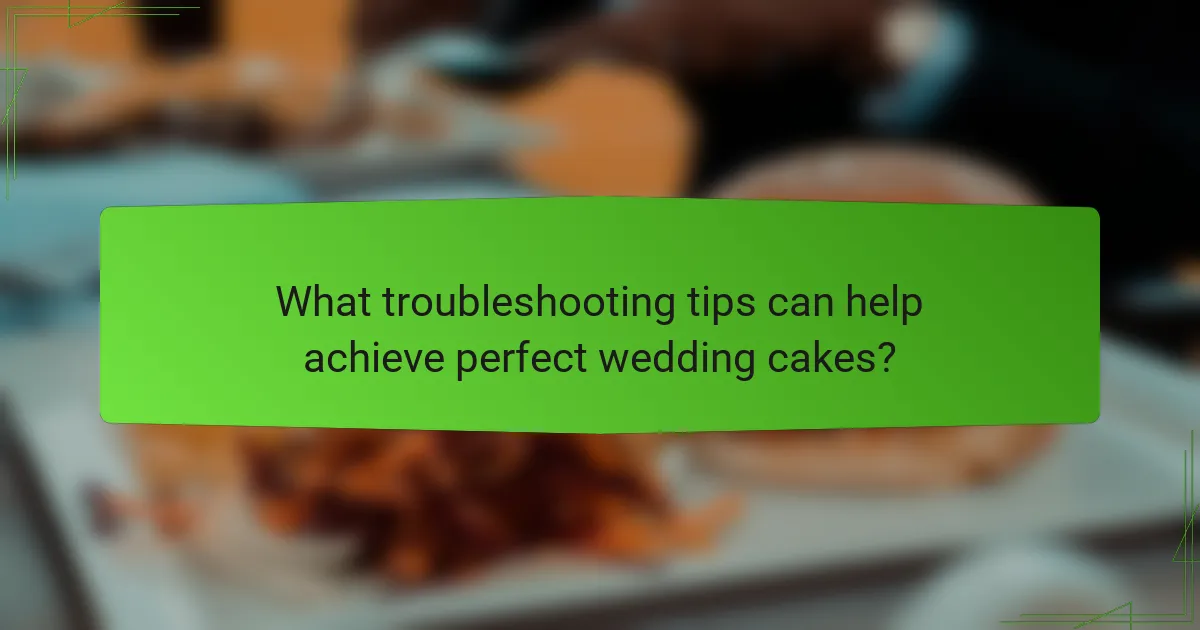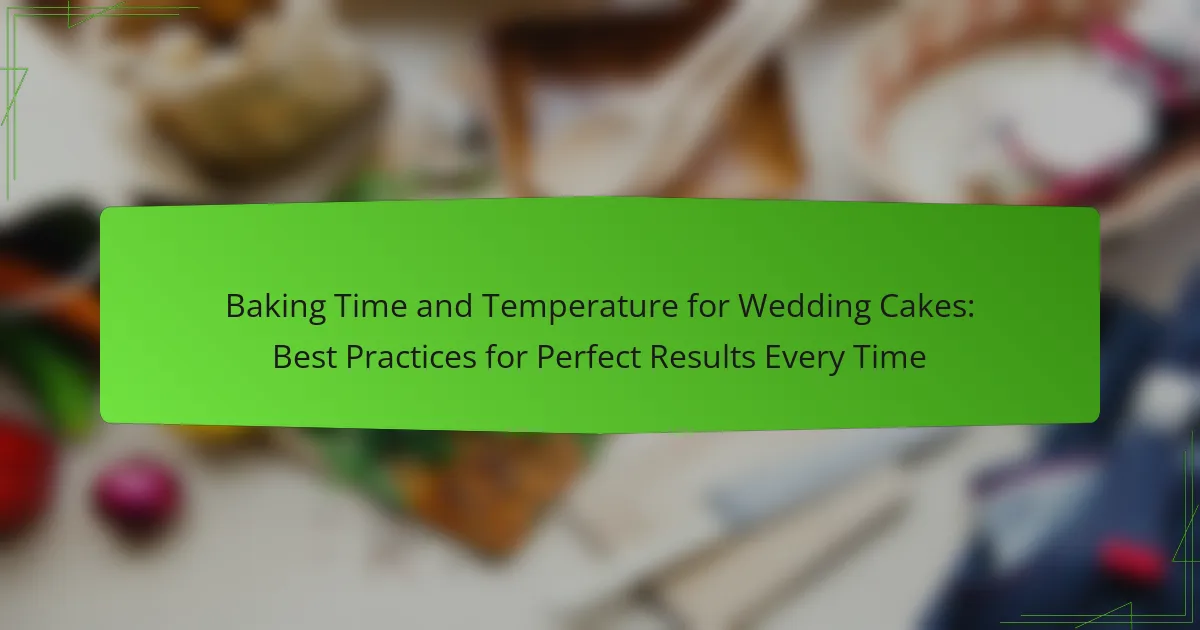
What are the essential factors in baking wedding cakes?
The essential factors in baking wedding cakes include ingredient quality, precise measurements, and proper mixing technique. Quality ingredients, such as fresh eggs and high-quality flour, significantly impact the cake’s texture and flavor. Accurate measurements ensure the right balance of dry and wet ingredients. Mixing technique is crucial; overmixing can lead to a dense cake, while undermixing can result in uneven texture.
Baking temperature is also vital. A consistent oven temperature prevents uneven baking. Additionally, using the right baking pans affects the cake’s shape and cooking time. Cooling and decorating techniques are important as well, as they influence the final presentation. Each of these factors contributes to achieving a wedding cake that is both beautiful and delicious.
How does baking time affect the texture of wedding cakes?
Baking time directly influences the texture of wedding cakes. Longer baking times can lead to a drier texture. This occurs because excessive heat evaporates moisture from the cake. Conversely, insufficient baking time can result in a dense and gummy texture. Cakes that are underbaked do not set properly, affecting their structure. The ideal baking time varies depending on cake size and recipe specifics. For example, a standard 8-inch cake typically bakes for 25 to 30 minutes. Monitoring the cake closely ensures it achieves the desired texture. Properly baked wedding cakes should be moist yet firm, creating a balanced mouthfeel.
What is the ideal baking time for different wedding cake sizes?
The ideal baking time for different wedding cake sizes varies. A 6-inch cake typically bakes for 25 to 30 minutes. An 8-inch cake usually requires 30 to 35 minutes. A 10-inch cake needs about 35 to 40 minutes. For a 12-inch cake, the baking time extends to 40 to 50 minutes. A 14-inch cake often takes 50 to 60 minutes. Finally, a 16-inch cake can bake for 60 to 75 minutes. These times ensure the cakes are fully cooked and achieve the desired texture.
How does the type of cake batter influence baking time?
The type of cake batter significantly influences baking time. Different batters have varying moisture levels and density. For instance, a dense batter, like pound cake, requires a longer baking time than a light batter, such as angel food cake. Additionally, batters with high fat content, like butter cakes, may bake faster due to better heat conduction. Conversely, batters with more liquid, such as those containing fruit or syrup, often need extra time to set properly. The baking temperature also plays a role; higher temperatures can shorten baking time but may lead to uneven cooking. Therefore, understanding the specific characteristics of each batter type is crucial for achieving optimal baking results.
What role does temperature play in baking wedding cakes?
Temperature is crucial in baking wedding cakes as it affects the cake’s texture, rise, and overall quality. Proper oven temperature ensures even baking, preventing undercooked or burnt sections. For most wedding cakes, a temperature of 325°F to 350°F is ideal. This range allows for a gradual rise, creating a light and fluffy texture.
If the temperature is too low, the cake may not rise adequately. Conversely, if it’s too high, the exterior may cook too quickly, leaving the interior raw. Accurate temperature control is essential for achieving a consistent crumb and preventing collapse.
Using an oven thermometer can help verify the actual temperature, ensuring optimal baking conditions. Following these temperature guidelines leads to a beautifully baked wedding cake that meets expectations.
What is the recommended oven temperature for wedding cakes?
The recommended oven temperature for wedding cakes is typically 325°F (163°C). This temperature allows for even baking and helps prevent the cake from rising too quickly. Baking at 325°F ensures that the cake remains moist and tender. Cakes baked at this temperature usually take about 25 to 35 minutes to bake, depending on their size and recipe. Many professional bakers agree that this temperature is ideal for achieving the best texture and flavor in wedding cakes.
How can temperature variations impact cake outcomes?
Temperature variations can significantly impact cake outcomes. Higher temperatures can cause cakes to rise too quickly, leading to a dome shape and potential collapse. Conversely, lower temperatures may result in dense, undercooked cakes. The Maillard reaction, which gives baked goods their color and flavor, occurs optimally at specific temperatures. If the temperature is too low, this reaction may not happen adequately, affecting taste. Additionally, temperature fluctuations can alter baking times. For instance, cakes may require longer baking at lower temperatures. Accurate temperature control is essential for achieving the desired texture and flavor in cakes.

What are the best practices for determining baking time and temperature?
The best practices for determining baking time and temperature include following a reliable recipe, preheating the oven, and using an oven thermometer. Recipes provide specific temperature and time guidelines tailored to the cake type. Preheating the oven ensures even baking from the start. An oven thermometer verifies that the actual temperature matches the set temperature.
Baking times can vary based on cake size and pan material. For instance, a larger cake requires a longer baking time. Checking for doneness is crucial; inserting a toothpick should come out clean or with a few crumbs.
Adjustments may be necessary for altitude or humidity variations. Higher altitudes often require lower temperatures and longer baking times. Keeping these factors in mind ensures consistent and successful baking results.
How can I accurately measure baking time for wedding cakes?
To accurately measure baking time for wedding cakes, preheat the oven to the correct temperature before placing the cake inside. Use a timer to track the baking duration based on the recipe guidelines, typically ranging from 25 to 45 minutes depending on the cake size and type. Insert a toothpick or cake tester into the center of the cake to check for doneness; it should come out clean or with a few moist crumbs. Adjust baking time as needed, particularly for larger cakes, which may require additional time. For precise results, use an oven thermometer to ensure the temperature is accurate, as oven temperatures can vary. Regularly check the cake during the last few minutes of baking to prevent overcooking. These methods ensure that the cake is baked evenly and thoroughly, resulting in a perfect wedding cake.
What tools can help ensure precise baking time?
Oven thermometers help ensure precise baking time. They measure the actual temperature inside the oven. This prevents discrepancies between the set temperature and the actual heat. Kitchen timers are essential for tracking baking durations. They provide accurate countdowns to avoid under or overbaking. Digital scales are useful for measuring ingredients accurately. Precise measurements contribute to consistent baking results. Baking mats can help distribute heat evenly. This ensures uniform baking across the cake. Using these tools leads to better baking outcomes.
How do I know when my wedding cake is done baking?
Your wedding cake is done baking when a toothpick inserted in the center comes out clean. This indicates that the batter has fully set. Additionally, the edges of the cake should start to pull away from the sides of the pan. The cake should also spring back when lightly pressed in the center. Most wedding cakes bake between 25 to 35 minutes, depending on size and oven temperature. Using a kitchen thermometer, the internal temperature should reach 210°F for doneness. These methods ensure your cake is properly baked and ready for cooling.
What techniques can improve baking temperature consistency?
Using an oven thermometer can significantly improve baking temperature consistency. This device accurately measures the internal temperature of the oven. Many ovens have temperature variations that can lead to uneven baking. Preheating the oven thoroughly before placing the cake inside also helps maintain a stable temperature. Additionally, rotating the cake halfway through baking ensures even exposure to heat. Avoiding frequent oven door openings prevents heat loss. Using dark, non-reflective bakeware can enhance heat conduction. Lastly, baking multiple cakes at once may require adjusting the temperature to accommodate the extra mass. These techniques collectively contribute to more reliable baking results.
How does preheating the oven affect baking results?
Preheating the oven ensures that it reaches the desired temperature before baking begins. This process promotes even cooking and consistent results. When the oven is preheated, baked goods rise properly and develop the right texture. For example, cakes require a specific temperature to activate leavening agents effectively. If the oven is not preheated, it can lead to uneven baking and undesirable results. Research shows that starting with a preheated oven can reduce baking time by up to 25%. This leads to better moisture retention and flavor development in the finished product.
What adjustments should be made for different oven types?
Adjustments for different oven types include temperature changes and baking time modifications. Conventional ovens typically require a temperature reduction of 25°F compared to recipes designed for convection ovens. This is due to the more even heat distribution in convection ovens.
Baking times may also differ; cakes often bake faster in convection ovens. For example, a cake that takes 30 minutes in a conventional oven may only need 25 minutes in a convection oven.
For toaster ovens, it is crucial to monitor closely, as they can have hot spots. Adjustments may include rotating the cake halfway through baking.
Additionally, gas ovens may require a slight increase in temperature due to less consistent heat. Baking times can vary based on the specific model and its heat settings.
These adjustments ensure optimal baking results for wedding cakes across various oven types.

What troubleshooting tips can help achieve perfect wedding cakes?
To achieve perfect wedding cakes, ensure accurate measurements for all ingredients. Use a kitchen scale for precision. Maintain proper oven temperature by using an oven thermometer. Avoid overmixing the batter to prevent dense cakes. Check for doneness by inserting a toothpick; it should come out clean. Allow cakes to cool completely before frosting to prevent melting. Use a serrated knife to level layers for even stacking. Store cakes in a cool, dry place to preserve freshness.
What common baking mistakes should I avoid?
Common baking mistakes to avoid include not preheating the oven. A preheated oven ensures even baking. Another mistake is using incorrect measurements. Accurate measurements affect the texture and taste of the cake. Overmixing the batter can lead to a dense cake. Mixing should be just enough to combine ingredients. Not using the right pan can also cause issues. Different pans conduct heat differently, impacting baking time. Failing to check for doneness is a frequent error. Using a toothpick to test the center can prevent undercooked or overcooked cakes. Lastly, opening the oven door too often can disrupt temperature stability. Maintaining consistent heat is crucial for proper baking.
How can overbaking affect the final product?
Overbaking can significantly alter the final product of baked goods. It typically results in a dry texture due to excessive moisture loss. Overbaked items may also develop a hard crust, making them less enjoyable to eat. Additionally, the flavors can become intensified or burnt, leading to an unpleasant taste. For cakes, overbaking can cause them to shrink away from the sides of the pan. This shrinkage can create an uneven appearance and affect the overall presentation. Baking at the correct time is essential for maintaining the desired texture and flavor in wedding cakes. Studies indicate that cakes should be monitored closely, as even a few extra minutes can lead to overbaking.
What should I do if my cake sinks in the middle?
If your cake sinks in the middle, you should first check the baking time and temperature. Cakes often sink due to underbaking or excessive moisture. Ensure your oven is properly calibrated to the correct temperature. A common baking temperature for cakes is around 350°F (175°C).
Next, avoid opening the oven door frequently during baking. This can cause fluctuations in temperature. Additionally, ensure that you are using the correct size of pan for your batter. A pan that is too small can cause the cake to rise too quickly and then collapse.
If the cake has already sunk, you can try to salvage it. You may cover the sunken area with frosting or fruit. This can help mask the appearance of the sink. Remember, cakes may sink due to various factors, including ingredient ratios and mixing techniques. Adjusting these elements in future baking can lead to better results.
What are some expert tips for perfect baking results?
Use room temperature ingredients for even mixing. This ensures better incorporation and texture. Preheat the oven to the correct temperature before baking. Accurate heat is crucial for proper rising. Measure ingredients precisely for consistency. Baking is a science that relies on exact measurements. Rotate the baking pan halfway through to ensure even cooking. This prevents hot spots in the oven from affecting the cake. Use the toothpick test to check for doneness. A clean toothpick indicates the cake is fully baked. Allow cakes to cool in the pan for a short time before transferring. This helps maintain the cake’s structure. Follow these tips for consistently perfect baking results.
How can I ensure even baking throughout the cake?
To ensure even baking throughout the cake, use the correct oven temperature. Preheat the oven to the recommended temperature for your recipe. Use an oven thermometer to verify accuracy. Position the cake in the center of the oven for optimal heat circulation. Avoid opening the oven door frequently, as this can cause temperature fluctuations. Use light-colored, non-reflective bakeware to promote even heat distribution. Rotate the cake halfway through baking to account for hot spots in the oven. Follow these practices to achieve consistent results in cake baking.
What should I consider when baking multiple wedding cakes at once?
When baking multiple wedding cakes at once, consider your oven’s capacity. Ensure it can accommodate all cakes without overcrowding. Overcrowding can lead to uneven baking and temperature fluctuations. Preheat the oven thoroughly before placing cakes inside. Monitor baking times closely, as they may vary with multiple cakes. Use separate baking pans for each cake to maintain even heat distribution. Rotate cakes halfway through baking for consistent results. Finally, allow adequate cooling space for each cake to prevent condensation and sogginess.
The main entity of this article is wedding cakes, specifically focusing on the essential factors of baking time and temperature. Key topics include the importance of ingredient quality, precise measurements, and mixing techniques that affect cake texture and flavor. The article also outlines recommended baking times for various cake sizes and discusses how batter type and oven temperature impact baking outcomes. Additionally, best practices for ensuring consistent baking results, troubleshooting tips, and expert recommendations are provided to help achieve perfect wedding cakes every time.
